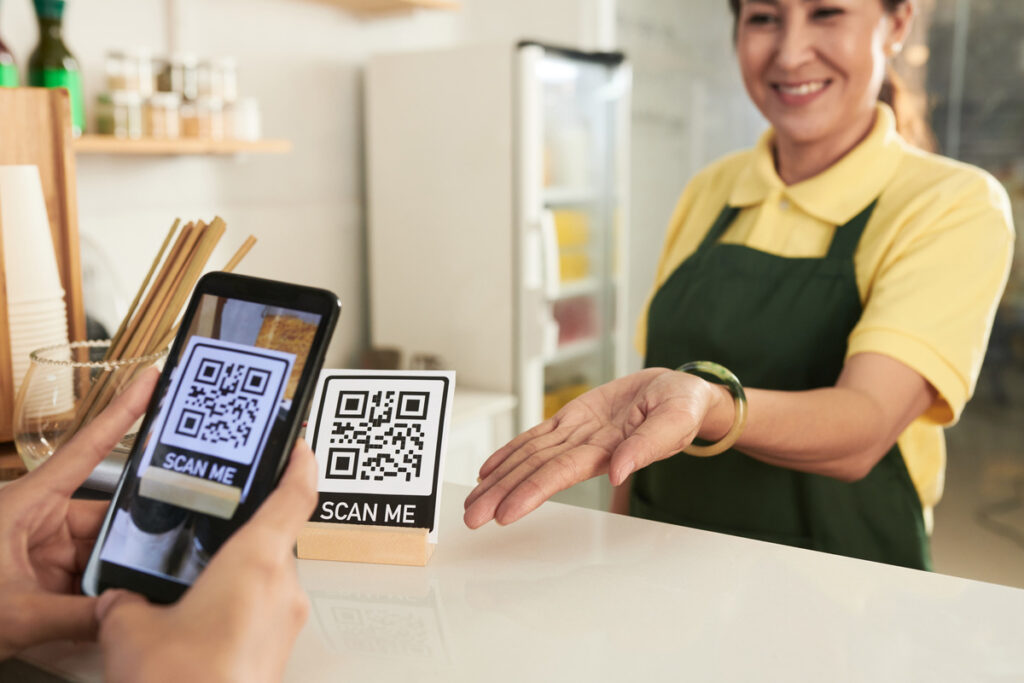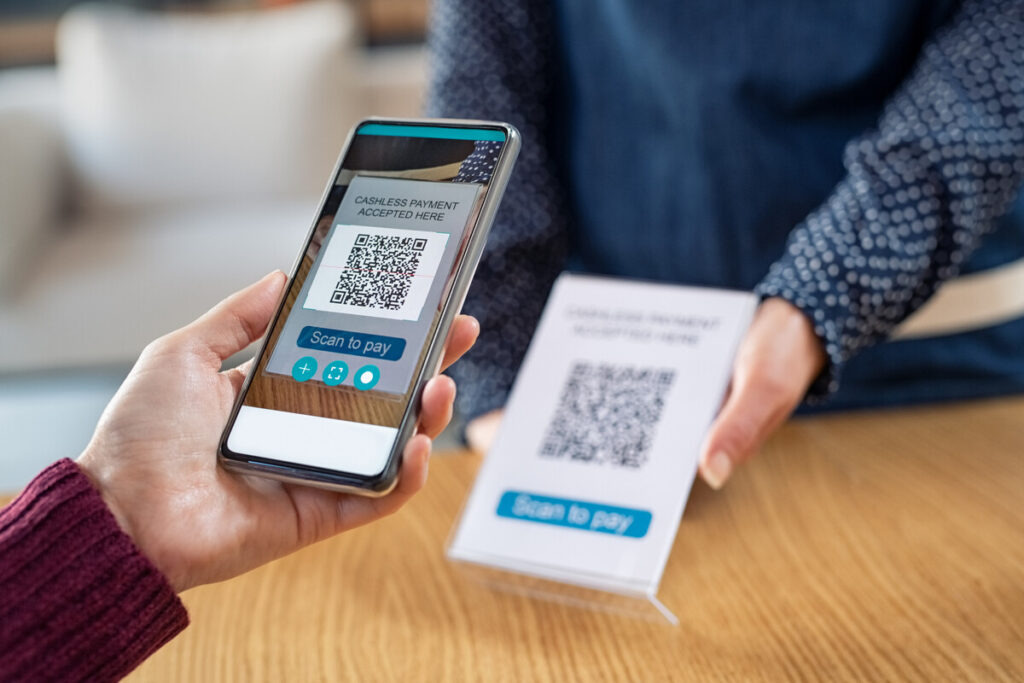
February 15, 2024
How do QR codes work for payments?
As businesses seek more user-friendly and secure payment methods, QR codes have become a key player in revolutionizing transactions. These compact, square-shaped codes offer a smart, streamlined way to process payments, blending modern technology with everyday convenience. By transforming traditional payment methods, QR codes redefine the transaction experience for businesses and consumers.
How do I set up a QR code for payment?
The setup process is user-friendly for businesses looking to adopt QR code payments. It involves selecting a payment processor supporting QR technology, creating an account, and generating a unique QR code that links to this account. This code can be displayed for customers to scan and execute payments.
What are the disadvantages of QR code payment?
Despite their convenience, QR codes have some limitations. One significant challenge is the need for a smartphone and a compatible app, which might exclude some customers. Additionally, there are concerns about the security of transactions and the potential for QR code manipulation.
How can someone pay with a QR code?
Paying with a QR code is remarkably straightforward. Customers use their smartphones to scan the code using a payment app, which prompts them to confirm the payment details before processing the transaction.
What are the risks of QR code payment?
The primary risks involve security concerns, such as the potential for scanning malicious QR codes, leading to fraudulent transactions or data breaches. Users are advised to scan codes only from trusted sources.
Why is a barcode better than a QR code?
Barcodes may be preferred in scenarios where simplicity and familiarity are key. They are easier to scan with basic equipment and are widely used in retail. However, QR codes offer greater storage capacity and versatility.
How can I get a QR code for my business?
Obtaining a QR code for business use involves registering with a payment service provider that supports QR code payments. These providers offer tools to generate and manage QR codes linked to the business’s payment account.
What is the merchant charge for a QR code?
Merchant charges for QR code payments can vary significantly depending on the provider and the specific payment plan. Generally, there are several models that payment service providers follow:
- Free services: Some providers offer QR code payment services at no cost, especially as a part of a broader package of merchant services. These are typically aimed at small businesses or those new to QR code payments.
- Per transaction fees: Many providers charge a small fee per transaction. This fee is usually a percentage of the transaction amount, sometimes coupled with a fixed nominal fee. This model is beneficial for businesses with fluctuating sales volumes.
- Monthly subscriptions: Some providers offer monthly subscription models for businesses with consistent transaction volumes. These plans often come with a set number of monthly transactions for a fixed fee, beyond which per transaction charges may apply.
- Tiered pricing models: Larger businesses or those with high transaction volumes might opt for tiered pricing models, where the per-transaction fee decreases as the number of transactions increases.
Understanding these pricing structures is crucial for businesses to choose the most cost-effective QR code payment solution that aligns with their sales patterns and volume.
How do you receive money with a QR code?
When a customer scans a business’s QR code with their smartphone, the process for receiving money is typically as follows:
- Scanning: The customer uses their payment app to scan the QR code, which contains the merchant’s payment information.
- Transaction processing: The payment app decodes the QR code and prompts the customer to enter the payment amount (unless it’s pre-set) and confirm the transaction.
- Funds transfer: Upon confirmation, the transaction is processed instantly. The funds are transferred from the customer’s account to the merchant’s account linked with the QR code.
- Notification: The merchant receives a notification (usually via the payment app or an SMS/email alert) confirming the transaction’s success and the receipt of funds.
This process is highly automated, requiring minimal manual intervention from the merchant, making it a convenient and efficient method for accepting payments.

How do I get paid for a QR code?
To get paid through a QR code, a merchant needs to follow these steps:
- Set up: Register with a payment service provider that offers QR code payment solutions and link the business bank account.
- Generate QR code: Create a unique QR code for the business through the provider’s platform. This QR code is linked directly to the merchant’s account.
- Display QR code: Position the QR code strategically at the point of sale or on invoices for easy customer scanning.
- Receive payments: When a customer scans the QR code and completes a payment, the amount is directly credited to the merchant’s linked account.
- Confirmation: The merchant receives a real-time confirmation for each transaction, often accompanied by a digital receipt.
This streamlined process ensures that payments are processed quickly and securely, with minimal manual handling required.
Can anyone take money from QR code?
QR codes are designed primarily for depositing money and not for withdrawals. They contain information that directs payments to a specific merchant account and cannot be used to extract funds from that account. Key points include:
- Security measures: Modern QR code systems are equipped with various security features to prevent unauthorized access to funds.
- One-way transactions: The transaction process through a QR code is unidirectional, meaning it only allows the flow of funds into the linked account.
- Controlled access: Only the merchant or authorized personnel can access the account linked to the QR code, ensuring that authorized parties can access funds.
However, merchants must secure their QR codes and associated accounts, as the misuse of QR codes (such as displaying a tampered or fraudulent code) could lead to unauthorized transactions.
Benefits of using QR codes for payments
QR codes offer a multitude of benefits for payments, particularly for businesses looking to streamline their transaction processes:
- Convenience: QR codes allow quick and hassle-free transactions, improving customer experience.
- Cost-effective: They often require less hardware investment compared to traditional payment systems.
- Enhanced Security: QR codes can reduce the risk of physical theft and are generally encrypted for secure transactions.
- Versatility: They are adaptable to various business models and can be used for in-person and online payments.
- Speed: Transactions via QR codes are typically faster than traditional payment methods, leading to improved efficiency.
- Customer reach: QR codes can attract tech-savvy customers and those who prefer contactless payments.
- Reduced contact: In the post-pandemic era, QR codes offer a hygienic, contactless payment option.
- Data tracking: They can track customer behavior and preferences, aiding in targeted marketing and business strategy development.
These benefits collectively contribute to an enhanced transactional framework, aligning with the evolving needs of both businesses and customers in the digital age.
In conclusion, adopting QR codes for payments marks a significant step forward in financial transactions, offering simplicity, security, and speed. As we embrace these innovative solutions, choosing the right platform to support and enhance these payment methods is crucial.
Gr4vy stands out as a robust payments platform, uniquely designed to empower your business in this evolving payment landscape. With its ability to deploy, manage, customize, and optimize all your payments through a single, universal integration, Gr4vy simplifies the complexities often associated with diverse payment methods, including QR codes.
The platform’s single-tenant, cloud-based infrastructure ensures a high level of security and customization and paves the way for seamless scalability. Whether you’re looking to expand your business or streamline your existing payment processes, Gr4vy offers a solution tailored to your needs, helping your business grow faster and more efficiently.